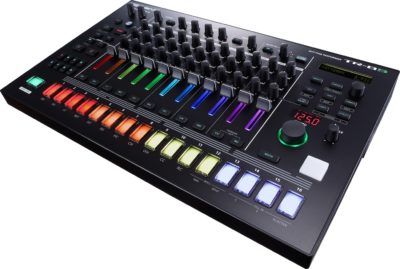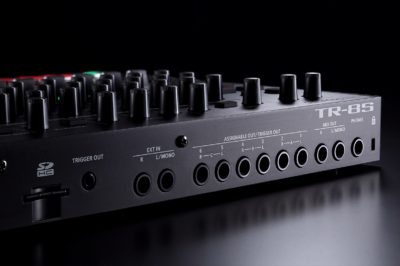New Gear Review: TR-8S Rhythm Performer by Roland

Roland’s TR-8S is the next step in the evolution of their classic TR series drum machines, paying homage to their timeless sound while still pushing the design into new and exciting territories.
A few years ago, Roland released the AIRA series of virtual analog synths in to the marketplace.
The TR-8, a drum machine which featured sounds from the classic 808 and 909 Rhythm Composers, was well-received in the music making community.
Over the four years since its release however, users have had the chance to voice their opinions on how the TR-8 could be improved… and Roland has listened.
Earlier this year, the TR-8S was unleashed into the wild, incorporating many of the features that Roland’s users have requested. This updated version takes the original to a whole new level. While essentially keeping the same form factor, Roland have updated and improved upon nearly every aspect of the TR-8.
Features and Use
The first thing that I checked out upon powering up the TR-8S was its sound library. I was immediately blown away by the sheer number of sounds! And, as I searched through the library, I noticed that Roland have done something really clever with their labeling, by adding letters to the top of the screen to show where each sound originated.
For example, P = Analog-modeled sounds (featuring Roland’s Analog Circuit Behavior), S = Samples, L = Loops, U = User-imported samples. These indicators make the process of finding the type of sound you need very easy. It’s a nice little touch that I didn’t expect, but I’m glad it’s there.

The TR-8S features detailed circuit models and every sound available in the most popular TR machines, including the 808, 606, 909, 707, 727.
Genre-wise, Roland have got the bases covered. No matter what you’re into or trying to make, there’s a sound for it. From DnB and Jungle, to House, Techno, and Trance, to Hip-Hop, RnB, and Soul—all the main electronic styles are there. Not only did Roland include drum sounds, but they also have instruments like basses, lead sounds, plucks, and chords available… and they all sound good.
And if the onboard sounds still aren’t enough, then you can add your own samples into the mix. This is as easy as popping your SD card into the slot on the back of the unit, or connecting the TR-8S to your computer directly and dragging the samples over.
For programming, you can still do it the original way via the 16-step sequencer. The big addition here is that, instead of 16 patterns, there are now 128, and instead of 2 variations for each pattern, there are now 8. That is a huge upgrade from the original TR-8. Live musicians rejoice; with all this open variety at your fingertips, you won’t have to program over a previously used pattern for a long time.
While on the subject of the sequencer, I want to point out that if you are someone who is into polyrhythms and non-linear rhythms, Roland have added the ability for each track of a pattern loop to be set to its own length. So, for example, your kick can be 16 steps, while your closed hat can be 12 steps.
If the step sequencer is not your thing, and you want to physically play your beats into the unit like an MPC, Roland have included a velocity-sensitive pad on the right side of the machine to tap out the rhythms. This is a great alternative; some people’s brains just aren’t built for performance, and this will help them get more out of the unit.
Another cool add-on that isn’t really necessary, but still nice, is the addition of the Trigger Out on the back of the unit. This CV Gate Output is crucial for those of us who own Eurorack analog gear. You can access its sequencing by pushing the CC and RC pads together, which brings up a new track for just this purpose—there are no controls. When I first heard about this feature, I couldn’t wait to try it out with my friend’s Make Noise synth. I hooked them up, then ran the audio out from the synth into the external input on the back of the TR-8S. The setup was easy, and it resulted in a really cool percussive addition to the drum machine’s sound.
Aside from the Trigger Out, there are 6 extra audio output jacks on the back of the machine. These can be set up as 3 stereo pairs, or 6 mono outs. If analog isn’t your thing, every channel can be sent via USB to your computer, where you can set up your DAW to track and record each instrument individually.
The individual outputs come in handy if you want to run your sounds through various outboard gear, but if you don’t have fancy compressors and other effects lying around, there’s plenty of onboard effects. You can choose from a number of useful options (like a compressor, filter, and EQ, to name a few), available for each instrument. Although it does require consulting the manual to set this up, it’s not that hard, and it makes a huge difference to the sound when you apply the right effects.
Unlike the original TR-8, which had compression on just the kick and snare, this new machine has the ability to insert a compressor on every instrument. If compression isn’t what the sound needs, there are a plethora of other effects you can choose from. The kits you build can have one insert effect on every track, and all tracks can be individually routed to the reverb and delay at customized levels, much like you would on a standard mixer. These effects allow you to add much more depth to your kits, and really fill them out in live settings, without the need for tons of extra outboard gear.
And to reiterate, the sounds are great, they fit well into a mix, and it’s easy to get unique and inspiring results using the onboard effects. There are filters, for example, which can be adjusted using the CTRL knob for each channel. This CTRL knob is user-assignable, so you can set it to control whatever you want and let your creativity run wild.
In the tactile department, the TR-8S is sturdy, which isn’t surprising since the original TR-8 also felt really good. Although it is made of plastic, the machine seems like it can take a bit of a beating without snapping apart. The shape of the TR-8S is also a bit boxier than the original, and I kind of like this one better. It’s easier to hold onto, which is nice if you plan to load it into and out of a gig bag often (as I do). All in all, the layout of everything is great. If you own the original, you’ll notice that certain buttons have been moved around, but after using it for a few days, this is something you easily get used to.
To Be Critical
Overall, I really like this machine and feel there isn’t all that much to critique. That said, I do wish there were detents on the control row of knobs. This wouldn’t be that big of a deal, except that the default setting for a lot of the sounds have a Pioneer-style filter, where turning the knob counterclockwise gives you a low pass filter, and turning it clockwise gives you a high pass filter. This means that pinpointing the exact middle point between the two is really difficult. I’m quite OCD about certain things, and this affects me in a big way.
Another concern is that the knobs are closer together than on the older unit (which I own, and therefore was able to directly compare). With my big hands, this means I have to be a bit more careful that I don’t disrupt neighboring knobs while adjusting parameters. That said, it’s not that bad, and it wouldn’t influence my decision to purchase the unit or not—just something to consider.![]()
Summing it Up
The TR-8S is great step up from the original TR-8. The plethora of sounds that Roland have included, the ability to load your own sounds, and the addition of so many sequences to program make the TR-8S an extremely robust, flexible, and useful machine. With so much to offer, this unit will keep you busy and inspired for many long sessions without getting stale.
If you are looking for a drum machine to run your live set, the TR-8S will keep you going with sequences for days. With the original TR-8, I often found myself struggling with storage space in the machine for live gigs. That, along with the limited number of sounds, were my main gripes with older unit. Now those features have been addressed, along with so many other upgrades—all for a price that is quite reasonable: $699.
All in all, I strongly recommend considering the TR-8S, even if you already own the original TR-8… you won’t be disappointed.
Please note: When you buy products through links on this page, we may earn an affiliate commission.








[…] Source link […]